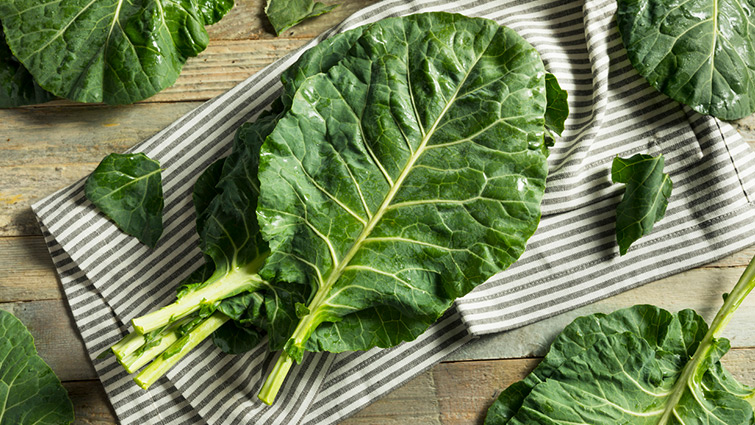Need a quick dip or a unique condiment? Wonderfully versatile, hummus is the best reason to keep a few extra cans of chickpeas and beans around. Try these tasty variations in your next sandwich or veggie wrap.
Recipe: Basil Pesto Hummus
Serving size: 2 oz.
Serving’s per recipe: 8
Prep time: 10 min
Cook time: 0 min
- 1 can - Chickpeas, 16 oz. drained and rinsed
- 2 Tbsp - Tahini, stirred well
- 8-10 ea - Basil leaves, fresh
- 1/2 ea - Lemon, juiced
- 1 Tbsp - Parmesan cheese, grated
- 1 clove - Garlic
- 3 Tbsp - Extra virgin olive oil + more for garnish
- Season to taste
Directions
Add all above ingredients to a food processor and pulse, scraping the sides as needed, until very smooth, about 4-6 minutes. Add more liquid, water or oil, to thin hummus as needed.
Basil Pesto Hummus Nutrition Facts
Serving size: 2 Tablespoons
| Calories | 121 |
| Carbohydrates | 11g |
| Fiber | 3g |
| Total Fat | 7g |
| Saturated Fat | 1g |
| Monounsaturated Fat | 4g |
| Polyunsaturated Fat | 2g |
| Protein | 4g |
| Sodium | 91mg |
| Sugar | 2g |
Recipe: Garlic Parmesan Hummus
Serving size: 2 oz.
Serving’s per recipe: 12
Prep time: 10 min
Cook time: 0 min
- 1 can - Chickpeas, 16 oz. drained and rinsed (reserve 1/4 cup liquid)
- 4 cloves - Roasted garlic
- 1/4 cup - Extra virgin olive oil + more for garnish
- 1/4 cup - Tahini, stirred well
- 1/4 cup - Parmesan cheese, grated
- 1/4 tsp - Cumin, ground
- 2 Tbsp - Lemon juice
- 1/4 cup - Reserved chickpea liquid or water
- Season to taste
Directions
Add all above ingredients to a food processor and pulse, scraping the sides as needed, until very smooth, about 4-6 minutes. Add more liquid, water or oil, to thin hummus as needed.
Garlic Parmesan Hummus Nutrition Facts
Serving size: 2 Tablespoons
| Calories | 105 |
| Carbohydrates | 8g |
| Fiber | 2g |
| Total Fat | 8g |
| Saturated Fat | 1g |
| Monounsaturated Fat | 4g |
| Polyunsaturated Fat | 2g |
| Protein | 3g |
| Sodium | 78mg |
| Sugar | 0g |
Recipe: White Bean Hummus
Serving size: 2 oz.
Serving’s per recipe: 8
Prep time: 10 min
Cook time: 0 min
- 1 can - White northern beans, 15 oz. drained
- 2 Tbsp - Lime, juice
- 2 Tbsp - Sriracha, or more, to taste + for garnish
- 2 cloves - Garlic
- 2 Tbsp - Cilantro leaves, chopped
- 1/8 tsp - Cumin, ground
- 1/8 tsp - Paprika, smoked
- 2 Tbsp - Extra virgin olive oil + more garnish
- Season to taste
Directions
Add all above ingredients to a food processor and pulse, scraping the sides as needed, until very smooth, about 4-6 minutes. Add more liquid, water or oil, to thin hummus as needed.
White Bean Hummus Nutrition Facts
Serving size: 2 Tablespoons
| Calories | 89 |
| Carbohydrates | 12g |
| Fiber | 3g |
| Total Fat | 3g |
| Monounsaturated Fat | 2g |
| Protein | 4g |
| Sodium | 136mg |
| Sugar | 0g |
Recipe: Veggie and Hummus Wrap
- Collard greens (for outside of wrap)
- Avocado
- Tomato
- Sprouts
- Cabbage, purple
- Cucumber
- Hummus of choice
Directions
Start building your wrap by coating the collard green with your choice of hummus. Continue layering with your choice of toppings leaving 1-inch strip at the top of the collard leaf. Carefully roll the wrap and enjoy!

Star Ingredient: Collard Greens
Collard Greens Contain:
Vitamin A*
When most people think of vitamin A, they think of their eyes. When vitamin A is lacking, the eye has difficulty adapting to changing light levels. Vitamin A is a versatile vitamin that also is involved with protein synthesis, reproduction and growth. The role that vitamin A plays in vision is undeniably important, but only one-thousandth of the body’s vitamin A is in the retina. Much more is in the skin and the linings of organs, where it participates in protein synthesis and cell differentiation.
Vitamin C*
Did you know the human body does not have the ability to produce vitamin C on its own? That’s why it’s so important to make sure we are eating a wide variety of foods with Vitamin C. This vital vitamin is not only useful to help our bodies fight off the common cold, but it’s necessary for the absorption of iron and very important for our connective tissues. Connective tissues are what keep our skin firm and our muscles strong. Because vitamin C supports our connective tissues, it is also useful in speeding up the healing process. If you have a wound, you might want to consider increasing the intake of foods higher in vitamin C.
Trivia: Cats and dogs can make vitamin C therefore they don’t need fruits and vegetables.
Vitamin K*
Vitamin K has long been known for its role in blood clotting. It also participates in the synthesis of several bone proteins. Bacteria in the intestinal track synthesize vitamin K that the body can absorb but people cannot depend on this source alone for vitamin K. Many foods contain ample amounts of vitamin K, notably green leafy vegetables and members of the cabbage family. If you are taking blood-thinning medication, be sure to talk with your Registered Dietitian or Physician about how much vitamin K is safe for you to consume.
*These statements have not been evaluated by the Food and Drug Administration. This is not intended to diagnose, treat, cure, or prevent any disease.

